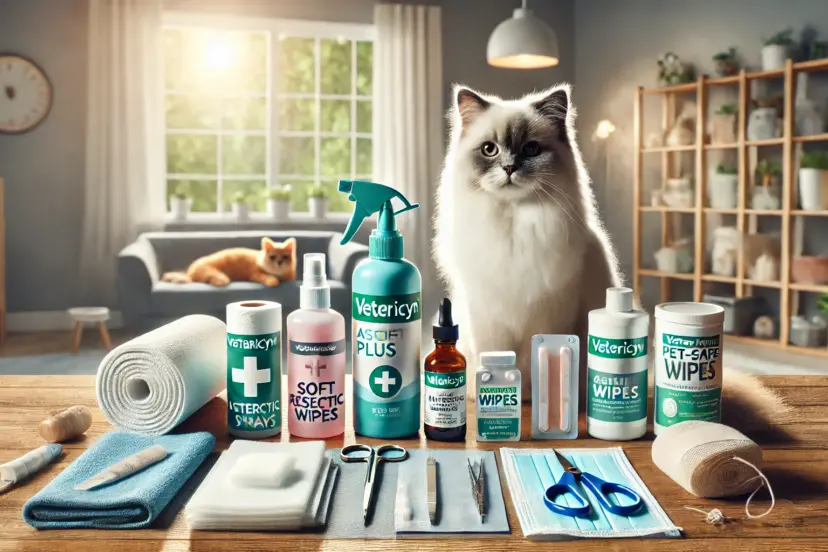Pet Wound Care: Guide to Keeping Your Furry Friend Healthy
We may earn a commission for purchases made using our links. Please see our disclosure for more details.
Let’s face it, our pets are members of the family, and their injuries cause worry for all those involved. Perhaps your cat is licking a place on their paw compulsively, or your dog comes running in from a backyard adventure with a new haircut. What are you doing? Pet wound care is easier than it seems, so don’t stress. Your pet will quickly be on the road to recovery with a little planning and some love.
Why Is Pet Wound Care So Important?
Consider your pet’s skin to be their own armor. Inviting problems is like leaving the front door open during a storm when that armor is breached. Wounds that are not properly cared for may develop infected, causing your pet more discomfort and you more stress. Taking care of wounds as soon as possible keeps things easy and guarantees that your pet heals more rapidly.
How to Spot a Wound on Your Pet
Sometimes it’s obvious—your dog’s tail is bleeding, or your cat has a scratch on their nose (probably from a backyard disagreement with another cat). Other times, it’s not as clear. Have you noticed your pet licking the same spot over and over or acting strangely protective of a paw or leg? Maybe they’re limping a little or seem uncomfortable when touched. These are all signs they might have a wound that needs your attention.
The Usual Suspects: What Causes Pet Wounds?
Pets can get themselves into trouble in the blink of an eye. Some common scenarios include:
- Roughhousing: Playtime with other pets sometimes leads to scrapes and bites.
- Outdoor misadventures: Thorny bushes, sharp rocks, or even a loose fence can leave their mark.
- Accidents: Slips, trips, and tumbles happen to pets too (ever see a cat miss a jump? It’s rare, but it happens).
- Surgical wounds: Post-surgery care is critical to ensure proper healing.
Types of Pet Wounds and What They Mean
Understanding the type of wound you’re dealing with is half the battle:
- Scratches and abrasions: Minor surface-level injuries.
- Cuts and lacerations: These go deeper and may need stitches.
- Puncture wounds: Often from bites or sharp objects—these can look small but cause big issues.
- Burns: Rare but serious, requiring immediate vet attention.
When to Call in the Professionals
Not every wound is a DIY project. If your pet has heavy bleeding that won’t stop after 10 minutes, a deep puncture wound, or a cut near sensitive areas like the eyes or mouth, it’s time to head to the vet. And if the wound starts looking infected—red, swollen, or smelly—don’t wait.
Your Pet Wound Care Kit: What to Keep on Hand
Think of this as your first-aid toolbox for furry emergencies. Here’s what you need:
- Clean towels or gauze (for those moments when you realize you’re out of paper towels).
- Pet-safe antiseptic solution.
- Blunt-tipped scissors.
- Tweezers for removing debris.
- Bandages.
- An Elizabethan collar (aka the cone of shame, but we call it the “halo of healing” in our house).
- Treats, because rewards make everything better.
Keeping Your Pet Calm (Good Luck!)
Let’s be real—most pets aren’t thrilled about first-aid treatment. Speak softly, offer gentle pets, and bribe them with treats. If they’re squirming like a toddler in a dentist’s chair, ask a friend or family member to hold them still.
How to Treat a Wound Step by Step
Ready to play nurse? Here’s the game plan:
- Assess the wound: Is it minor or something more serious?
- Stop the bleeding: Apply gentle pressure with a clean cloth or gauze.
- Clean it up: Use warm water or a pet-safe antiseptic (but skip the hydrogen peroxide—it’s harsh on their skin).
- Remove debris: Carefully use tweezers to pick out dirt or splinters.
- Add antibiotic ointment: Make sure it’s one that’s safe for pets.
- Cover it up: Bandage the wound, but don’t wrap it too tightly.
- Keep an eye on it: Check daily for signs of healing—or infection.
Don’t Overdo the Cleaning
Here’s a pro tip: Cleaning the wound is essential, but overdoing it can actually slow healing (think of it like scrubbing a bruise—it doesn’t help). Clean it gently once a day, and let the wound do its thing.
Managing Your Pet’s Pain
Let’s face it—pets are champs at hiding pain. If your pet seems uncomfortable, talk to your vet about pain relief options. And whatever you do, don’t give them human pain meds like ibuprofen—some of those are seriously toxic to animals.
Fighting Infections Like a Pro
Think of an infection as an uninvited guest. Here’s how to keep them out:
- Keep the wound clean and dry.
- Change bandages daily.
- Use that “halo of healing” collar to stop your pet from licking or biting the wound.
Can Natural Remedies Help?
For minor wounds, you might already have some healing helpers at home:
- Honey: Nature’s antibiotic.
- Aloe vera: A soothing balm for irritated skin.
- Chamomile tea: A gentle rinse for inflamed areas.
But always double-check that these remedies are safe for your specific pet.
Post-Surgery Care: The Home Stretch
Your pet just got back from the vet, and now it’s your turn to step up. Keep their surgical site clean and dry, follow any instructions to the letter, and use that cone if they try to scratch or lick. (It’s like watching a toddler who just discovered how to climb—constant vigilance.)
Dealing with Stubborn Pets
Some pets just don’t cooperate, no matter how many treats you offer. If yours keeps tearing off their bandage or won’t sit still, patience is your best tool. And yes, the cone will likely become your new best friend.
How Long Does It Take to Heal?
Healing time varies. Small scrapes can heal in days, while deeper wounds or surgical incisions might take weeks. Keep monitoring the wound and don’t hesitate to call the vet if something seems off.
Preventing Wounds Before They Happen
Prevention is the name of the game. Regular grooming can help you spot issues early, and making your pet’s environment safer—like checking for sharp edges or loose nails—goes a long way.
Your Pet’s Behavior After an Injury
A hurt pet might be clingier than usual—or the complete opposite. Watch for signs of stress or discomfort, and remember, a little extra TLC never hurts.
Wound Care Can Strengthen Your Bond
Here’s a silver lining: caring for your pet during an injury is a chance to strengthen your bond. Your patience and care show them that you’ll always have their back (or paw, or tail).
Scientific Research and Comprehensive Reviews Related to Pet Wound Care
Scientific research plays a pivotal role in enhancing our understanding of effective pet wound care. For instance, a study on canine allogeneic adipose-derived stem cell therapy demonstrated how stem cells significantly improve wound contraction and re-epithelialization, offering promising results for both acute and chronic skin injuries in dogs. Similarly, the use of essential oils in veterinary wound management has garnered attention due to their antimicrobial and anti-inflammatory properties, suggesting their potential as a natural adjunct in pet wound care.
Additionally, research on medicinal plants for canine dermatology highlights the healing properties of herbs such as marigold and chamomile, which possess antibacterial and antifungal benefits. Another significant breakthrough involves the effects of laser therapy in dogs, where studies reveal that laser treatments accelerate healing and improve the cosmetic appearance of surgical wounds. Lastly, clinical findings on lidocaine use in veterinary surgery confirm that this local anesthetic does not hinder wound healing, making it a reliable option for perioperative pain management.
These studies collectively emphasize the importance of integrating both innovative techniques and natural remedies to enhance wound healing in pets, providing invaluable insights for pet owners and veterinarians alike.
Essential Pet Wound Care Products
When it comes to tending to your pet’s wounds, having the right products on hand can make all the difference. Here are some top-rated items available on Amazon that can assist in effective pet wound care:
- Vetericyn Plus Dog Wound Care Spray
This healing aid and skin repair spray is designed to clean wounds and relieve skin allergies. It’s safe for all animals and comes in a 16-ounce bottle. - Remedy+Recovery Liquid Bandage for Dogs
An Amazon’s Choice product, this liquid bandage helps protect minor cuts and scrapes, promoting faster healing. - Silverquine Pet Wound & Itch Care
This product provides wound, coat, and skin care treatment for various conditions, including hotspots, burns, and scratches. It also offers relief for itching and dry skin. - Underwood Pet Wound Care Spray
A versatile and economical solution suitable for all animals, this antiseptic spray is gentle and easy to use, making it ideal for cuts, scrapes, and open wounds. - Terramycin Antibiotic Ointment
This ointment is effective for treating eye infections in dogs, cats, cattle, horses, and sheep. It’s a best-seller with numerous positive reviews. - Musher’s Secret Paw Protection Wax
Ideal for protecting and healing your dog’s paw pads and noses from dryness and cracking, especially during winter months.
These products are designed to assist in various aspects of pet wound care, from cleaning and protecting wounds to preventing infections and aiding in the healing process. Always consult with your veterinarian before introducing new treatments to ensure they’re appropriate for your pet’s specific needs.
Wrap-Up: You’ve Got This
Taking care of a pet’s wound might seem daunting, but with the right tools and mindset, you’re more than capable. Stay calm, follow the steps, and don’t be afraid to ask your vet for advice. Before you know it, your furry friend will be back to their happy, playful self—just with a little extra gratitude for their awesome human.
FAQs About Pet Wound Care
1. Can I use Neosporin on my pet’s wound?
Nope. Neosporin isn’t made for pets and might cause an allergic reaction. Stick to pet-safe antibiotic ointments.
2. How do I stop my pet from licking their wound?
Break out the cone of shame—it works! You can also try distracting them with toys or treats.
3. What if the wound smells bad?
A bad smell could mean infection. Call your vet right away.
4. Is alcohol okay for cleaning wounds?
Not at all! Alcohol stings and can damage tissue. Stick to warm water or vet-approved solutions.
5. How can I tell if the wound is healing?
Look for reduced redness, swelling, and healthy scabbing. If it seems worse instead of better, it’s vet time.
Your pet is counting on you—and with these tips, you’ve got what it takes to be their hero. 🐾




